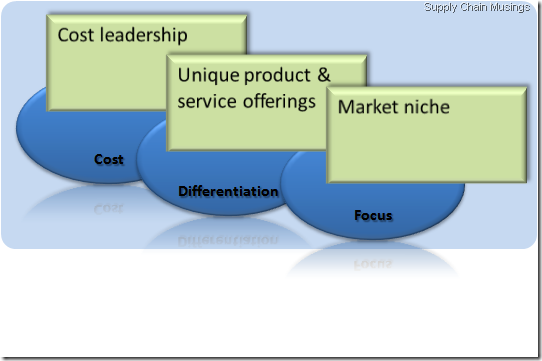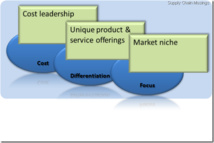Thestrategist.com – 24 April 2015 – Paul Daulerio writes about generic strategies that can affect a business. His first ‘generic’ strategy deals with “Low Cost Strategy” whereby companies invest to reach a competitive price advantage. The second with “Differentiation Strategy” while the third one with “Focus Strategy”.
The differentiation strategy is followed by any business or company when they have something unique to offer in terms of either service or product that renders the business concerned different than the rest of the competitors. Moreover, there are many “approaches to differentiation” such as “stellar brand image”, uniqueness of technology, keen customer-service and “enhanced warranties”.
Daulerio points out that while “pursuing a Differentiation Strategy” companies should not ignore the aspect of cost involved. In his words:
The differentiation strategy is followed by any business or company when they have something unique to offer in terms of either service or product that renders the business concerned different than the rest of the competitors. Moreover, there are many “approaches to differentiation” such as “stellar brand image”, uniqueness of technology, keen customer-service and “enhanced warranties”.
Daulerio points out that while “pursuing a Differentiation Strategy” companies should not ignore the aspect of cost involved. In his words:
“A Differentiation Strategy is simply one in which differentiation relative to competitors becomes the dominant competitive theme in a company/business.”
At times, the differentiation strategy can become a hindrance to secure “a high market share” due to the uniqueness of the services or products involved the perceptions of the customers can conflict with their numbers. Furthermore, launching unique products or services in the market would include “extensive” design-work, “protracted” research-studies along with the cost of quality material if required, whereby resulting in increased “sales-prices”. The higher cost may fail to attract a certain sector of customers. Daulerio concludes:
“...that this trade-off between uniqueness and cost is the fundamental reason why a company's/business's concurrent pursuit of a Low Cost Strategy and a Differentiation Strategy is virtually impossible.”
There is a heavy demand on the companies who follow the differentiation strategy to maintain a steady market position while enhancing their services or products. Therefore, it should be understood that differentiation strategy involves “substantial threats”, whereby holding on to the “brand loyalty” becomes difficult while deal in between “Low Cost Strategy” competitors and “Differentiation Strategy” ones. Moreover, there is a chance of customers losing their interest in the differentiated outcome while their perception of the said product may get “diluted through commoditization”.
However, “Focus Strategy” allows very narrow market segments as the competition platform. In fact, the target group of the said strategy deals with either “a particular consumer group” or “a specific segment of a product/service line” otherwise it can also be aimed at “a well-defined geographic market”.
The focus strategy can be a vehicle to achieve either lowering of cost in “a target market” or to differentiate oneself by matching the demand of one such market; in fact, in rare instances one both these results can be achieved.
The targeted market reduces the number of competitors while a select base of customers “is least vulnerable” to substitutive influence, although some “limitations in the overall market share” can be caused by the said strategy. Consequently, Daulerio writes:
“...a Focus Strategy inevitably involves a trade-off between profitability and sales volume/market share.
The risks involved in the above mentioned strategy comprises, as enlisted by Daulerio:
1. “(A)...narrowing of the differences in desired products/services between a target market and the market as a whole...”
2. “(A)...widening of the cost differential between broad-based competitors and target market competitors so as to eliminate the cost advantage of serving a target market and/or an offsetting of the differentiation advantages achieved through a target market approach.”



















